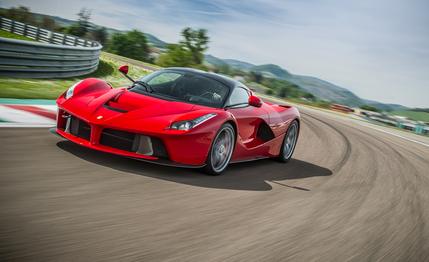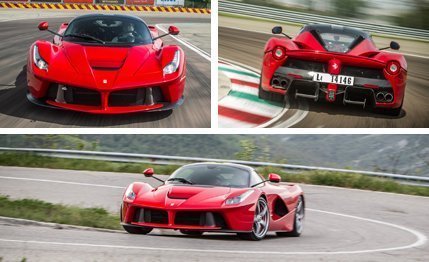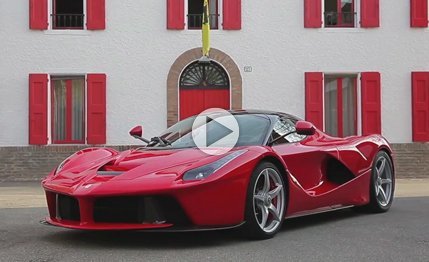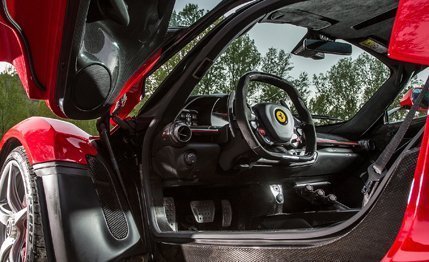 First Drive Review
First Drive Review
The night I was scheduled to leave for Maranello, Italy, to drive the LaFerrari, Car and Driver hosted a party in New York for the annual auto show. The guests included three racing heroes you’d recognize from the Kodachromes: David Hobbs, Sam Posey, and Brian Redman. These gents hail from the golden age of motorsport, when every race weekend seemed to darken into an orgy of gore and fire.
I apologized in advance to Redman for having to leave the party early. I told him that duty called, and that I was off to drive this car, the latest in a line of rolling laboratory experiments stretching back through the Enzo, F50, F40, and 288 GTO. I also confessed that I was slightly terrified to tangle with the thing. He sized me up and said, “You should be.”

I’ve driven cars that have tried to kill me before, but none with such a vast résumé of homicidal know-how. Some have threatened to slide off the road without warning, some have tried to collapse my organs with g-forces, and some have ached to impale me on their sharp interior surfaces. This one does it all. There is a video of Kimi Räikkönen, Ferrari F1 driver and a racer of almost Mario Andretti–like versatility, driving the LaFerrari (the TheFerrari?) at the brand’s Fiorano test track. There are flames spitting out of the car’s exhaust pipes. There are deafening shrieks. There is imminent loss of control at every corner. And then, finally, a lurid, frame-filling spin onto the grass. If Kimi couldn’t corral the surrealist bestiality packed into this car’s short wheelbase, what hope did I, someone who has never even been to Finland, really have?
The LaFerrari uses its stupid name as a feint, belittling a specification that is as serious as an Apollo mission. Its 950-hp hybrid powertrain shames Ferrari’s F14 T F1 car by maybe 200 horses (actual F1 power figures are undisclosed). Its center of gravity is 1.4 inches lower than the Enzo’s, and it uses a carbon-fiber tub baked in the same autoclaves as Ferrari’s F1 cars. At speed, its aerodynamics provide the car with one gorilla’s worth of downforce (800 pounds). The brakes are cross-drilled and vented carbon-ceramic rotors the size of crash cymbals.
There are more-powerful cars on sale. There are cars with more downforce and cars with even bigger and blacker brakes. But the LaFerrari represents a singularity. It is less a conventional supercar than a carefully orchestrated system of technologies resulting in something both brutally animalistic and mechanically pristine.

We are in Ferrari’s F1 shop, where Franco Cimatti, the head of road-car development, is backdropped by four huge autoclaves, big brewery-vat-looking things laid on their sides. This is where the LaFerrari’s carbon-fiber tub gets baked, right alongside those of the racing cars. Cimatti, thin, with close-cropped hair and wire-rimmed glasses, says: “If you get the physics right, everything else falls into place. A low center of gravity is key.”
He planned the car’s architecture around its seating position. His original idea was to lay the driver down into an almost F1-like recumbency: legs up and backrest at chaise angle. But he found that 32 degrees is as far as you can recline a non-F1–driving human before his front neck muscles start to compress and his breathing becomes strained. Still, Cimatti got the driver 2.4 inches lower than in the Enzo by easing him back a bit and removing the seat, separating the driver’s rear from the tub with just an Alcantara-swathed pad. Without a seat’s springs or compliance, there is no filter to muffle chassis feedback.
Without a seat, though, it would have been kind of awkward and somewhat humiliating to get in and out of the car. So Ferrari cut away the sills and integrated them into the batwings, hinging the now large and deep doors on the A-pillars and roof, endurance-car style. The arrowhead-shaped tub has the added effect of reducing frontal area for less drag; open those big portals and the exposed front wheels almost look as if they’re seceding from the body.
 Cutaway sills reveal the car's composite tub.
Cutaway sills reveal the car's composite tub.
The basic slipperiness and lift inherent to the shape led to a dynamic-aero solution to keep the LaFerrari stuck to the road. All its wings and flaps are hidden when the car is parked, but they are the most obvious things about it in motion. Front and rear undercar panels continuously manage downforce by moving from a low-drag, or flat, position to a high-drag setting folded into the slipstream. And a wide fluke at the back constantly changes pitch and height, rising out from underneath the trailing edge of the engine cover. At 125 mph, downforce ranges from 200 pounds in the low-drag settings to 800 pounds with all the flaps and wings reaching away from the body, radically upping the car’s stability and adhesion limit.
Part of the aero package is passive, too. There are channels in the shape that help air remain attached to the body while also funneling flow through the cooling system. And, indeed, the LaFerrari needs all the cooling it can get. Here are the main elements of the so-called HY-KERS (Hybrid Kinetic Energy Recovery System) powertrain: a 789-hp 6.3-liter V-12 with variable-length intake runners, a 13.5:1 compression ratio, and an Everestian 9250-rpm peak at redline; an oil-cooled 161-hp electric motor hung off the back of the seven-speed dual-clutch automatic; and a low-set, liquid-cooled lithium-ion battery pack that acts as a structural element aft of the passenger compartment.
Total system output is a claimed 950 horsepower, and it’s all orchestrated to highlight each element’s strength. It calls on the electric motor’s instantaneous response to provide a kind of boost, filling in the screaming V-12’s lower rev range. The result is a compound powertrain with shockingly smooth and immediate response; if you’re holding fourth gear and mash the throttle, you’ll swear from the kidney and lung compression that you were in second gear.